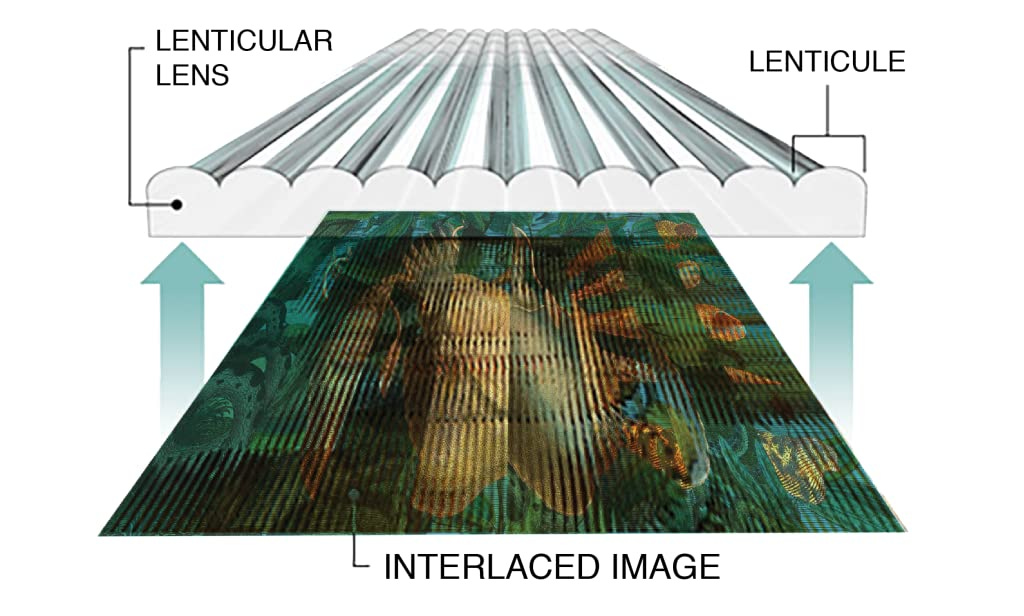I love lenticular lenses. I was 7 when I first saw a ruler with moving graphics on it, and ever since then, I’ve been mesmerized by that technology. For a long time, I wanted to know the trick: How are those images changing without anything moving or changing? Back then, the only thing I noticed was that the surface had a wavy surface texture, but not much more, and the fascination slowly started to fade into curiosity. I did a post that talked about them, but it was a part of much larger posts about illusions; this one focuses only on lenticular lenses.
During my college years, the fascination lit up again and I finally figured it out. and that fascination never left me up from that point.
So, what are lenticular lenses?
A lenticular lens is a thin, plastic sheet with rows of tiny curved “lenses” that look like evenly spaced waves when viewed from the side. The image itself is printed in a carefully interlaced way under the sheet, which means that multiple images (or frames) are sliced into narrow strips and then arranged side by side. Each tiny lens, or “ridge,” refracts light from a specific set of strips, so when you look at it from one angle, you see one picture, and as you shift your viewing angle, you see another.
The wave-like design is essential. Think of each ridge as a tiny magnifier directing one portion of the underlying image to your eyes. By changing where you stand or move your head, you’re effectively switching which strips you’re seeing magnified. That’s how lenticular prints can appear to morph from one image to another, show motion like a flipbook, or even create a 3D effect. The wave appearance is simply the geometry needed to bend light in controlled ways. Each ridge works like a mini lens, and lining them up in parallel rows naturally creates a surface that resembles ripples or waves.
This has one major drawback: the effect is only visible along the axis perpendicular to the lenses. If the lenses are placed vertically, it works only from left to right and has no effect when you move up or down.
Also, alignment of lenses to the underlying image is crucial as lenses can be really tiny, and even a hair width of misalignment could lead to the effect not working, and looking all messed up.
The effect can be achieved without lenses if images are printed or placed on the opposite sides of an accordion like folded structure, such prints are also known as Agamograph, and you can easily make one yourself. Take two images, slice them into equal-width sections, and glue them in sequential order onto a new piece of paper. For example, start with the first strip of the first image, then the first strip of the second image, and alternate until all strips are placed. Once everything is laid out, fold the paper in an accordion style so that each strip falls on a separate fold. When viewed from different angles, the final piece will reveal one image or the other, creating the agamograph’s unique “flip” effect. This does not have the fidelity of lenses but should illustrate the effect nicely.
Now, there is one interesting thing that you can do with lenticular lenses. Usually, they work by you moving them or you, in general, moving. But what happens if we move the lenses or the underlying image a teeny-tiny itsy-bitsy way? Prior static image starts to move regardless of whether we move or not.
If we take this principle to the extreme, we get a Looking Glass Holographic Monitor. 3D displays that don’t need any special glasses and are viewer independent are nothing new. They have been around for a couple of decades but what made them resurge is availability of high density displays. When you take into account that for each of the viewing angles, you in effect reduce the pixel count by double, it is fairly obvious that Full HD screens of yesterday were simply not good enough, and a minimum of 4k or higher is a minimum.
What they managed to do is create a thin “wave guide” (lenticular lenses) of high density and of perfect pitch to fit a display of also high density. The smallest version they are selling is called GO and is about $300.
I did a small test of some of the lenses I have lying around my lab, like this one with a lenticular lens sheet placed on my screen with an interlaced image in the background that I made in Photoshop.
I don’t think this will be the last I write about lenticular lenses, but for now, this is it.






